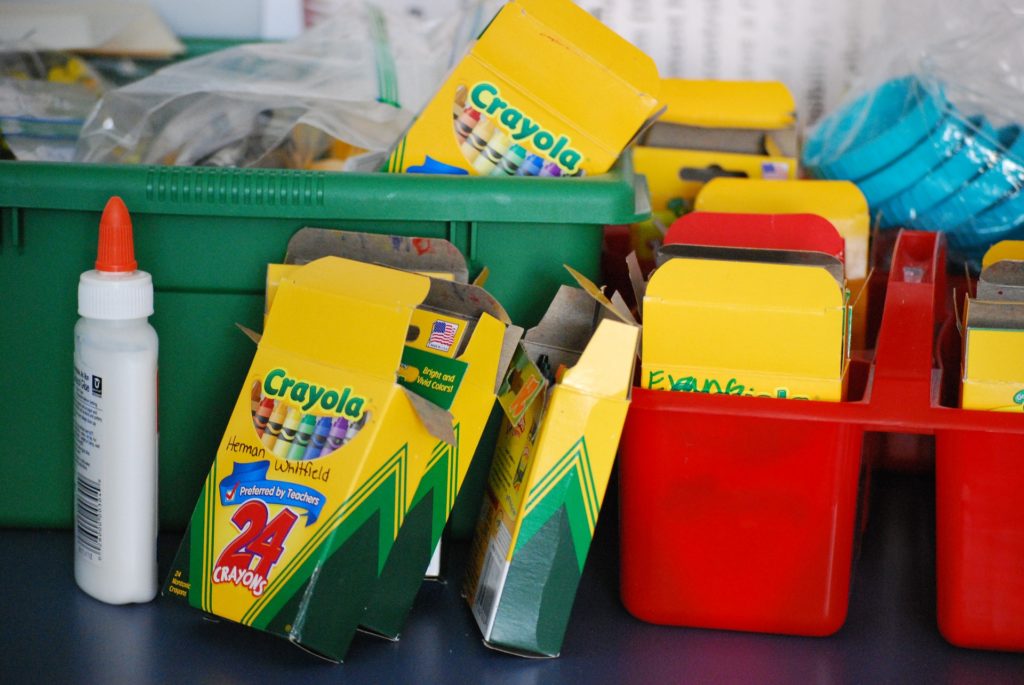Is there a teacher who doesn’t love brand-new school supplies? Perhaps, but I wouldn’t put money on it. Well, let me clarify. I believe most teachers get a charge out of new school supplies—just like kiddos do. What can be troubling for teachers is what to do with the avalanche of school supplies that arrive on the first day of school. Twenty No. 2 pencils per child adds up quickly!
 Some teachers request unlabeled supplies and gather the extra pencils, packs of paper, glue sticks, markers, crayons, tissue boxes, and so on into large bins where the items are stored until needed. I get this, and it seems like a decent idea, especially when a large number of supplies are requested at the start of the school year.
Some teachers request unlabeled supplies and gather the extra pencils, packs of paper, glue sticks, markers, crayons, tissue boxes, and so on into large bins where the items are stored until needed. I get this, and it seems like a decent idea, especially when a large number of supplies are requested at the start of the school year.
I personally like the idea of letting each child store her supplies in a personalize bin or large resealable plastic bag. It may sound like I don’t like to share, but that’s not it at all. I simply think students prefer to have ownership over their nifty new school supplies. I guess I’m remembering a conversation I had a few years ago in which a kindergartner’s description of her first day centered around the fact that her teacher had taken her supplies!
What works best for you and your kiddos?
Diane
PS: T-Bone, a class supply of glue sticks, and a nifty orange bag from The Mailbox are on my shelf ready to be delivered to one lucky teacher! To find out how to enter this giveaway—it’s super simple— click here. To be part of the random drawing, you must enter before midnight Sunday, August 14!

I have students keep their supplies in a tennis ball can, (plastic) That way they can see what they have and they have lids so if it falls off their desk, nothing spills out.
I use a freezer bag we label with the child’s names. Each child has their own. I make one for myself as well. We call them their tool bags. I review with them the first few weeks how we listen for the click when placing the lid on the marker. I look at it as teaching the children to be responsible for their things. When we are finished with the tools each child counts their crayons or markers depending on what they used and they place them back in the basket.
My class one year conducted a germ study and swabbed various surfaces that we thought might be germ problems areas. The worst culprit that produced the most bacteria in petri dishes were shared school supplies in the primary classrooms! These classrooms had common pencils, felts, crayons, erasers that the teacher had purchased in bulk and all students utilized. No child had their own supplies. Think about that when you are contemplating having shared supplies versus each child owns their supplies – especially around flu and cold season.
I have always shared supplies,refilling all as needed. However,IHAVE had kiddos who are really upset at that. I think that this year, I will discuss it with my class. I think that things like glue,pencils, and crayons could be shared, and let the kids keep folders and notebooks and scissors marked with their name. I would love to hear other ideas!
They get half to put it in their box. I then put the other half in bins. They get they as needed!
I let kids keep their supplies in their cubby. The extra glue sticks that they bring in I keep until it’s needed.
I always allow my students to keep folders, pencil boxes and other bigger items in their desks since these are usually special to them. Extra crayons, glue sticks, pencils, etc. are kept in my supply area. I do write names on extras so that the children who have supplied them do not get asked to bring them in again.
I have a translucent plastic shoe box with lid on my supply list. These are available for $1.00 many places. I create labels for the end of the containers with the child’s name. These stack neatly on a set of shelves I have for them. The kids are responsible for l Ettinger me know when they need more pencils, another wipe off marker etc The parents like knowing that the supplies that remain will come home in good condition at the end of the year.